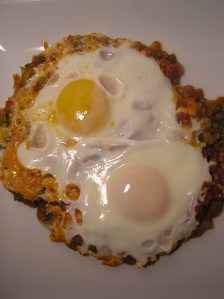 So remember back when I talked all about how inspired I was by my new book? Well, it took me forever, but I finally made a condiment. The easiest condiment in the book. Garlic-ginger paste. I made it last week. It’s been sitting there ever since. Well, not quite. I did slow cook some broccolini with a spoonful of the paste. Wow. Yum.
So remember back when I talked all about how inspired I was by my new book? Well, it took me forever, but I finally made a condiment. The easiest condiment in the book. Garlic-ginger paste. I made it last week. It’s been sitting there ever since. Well, not quite. I did slow cook some broccolini with a spoonful of the paste. Wow. Yum.
Well, since then I’ve been dreaming of a few different recipes. For one, Niloufer talks a lot about the Parsi obsession with eggs. And since I have a habit of eating eggs for just about any meal, those recipes have been calling to me. One of the methods she uses involves simmering a sauce (any type) in a wide, shallow pan, making little wells in the sauce, and cracking eggs into the wells to “poach” them. So that idea has been dancing around my brain. In another recipe, she utilizes onion tops. Yes, the green tops from scallions, spring onions, leeks, and even garlic. I practically survive on onions throughout the winter. I just love their variety. And each type can be cooked in a million different ways, producing such amazingly different results. So the onion top thing has been dancing in there too.
So tonight when did my daily scope-out-the-fridge-and-find-somethin’-for-dinner, I came across tomato sauce, spring onions, eggs, and my ginger-garlic paste. Aha! Dinner!
Have you ever eaten something sooooooo tasty that you didn’t even want to take a sip of water afterwards for fear of washing away the yumminess? That’s how I felt tonight. And this is what I did…
Parsi-eggs with tomato, spring onions, and ginger-garlic paste
serves 1
- 2 small spring onions or 1/2 bunch scallions, thinly sliced
- 1 teaspoon ginger-garlic paste (recipe to follow)
- 1 Tablespoon olive oil (or ghee, if you’re being authentic!)
- 1/2 cup homemade tomato sauce
- 2 eggs
Place a small, 8-inch saute pan over medium heat. Pour in the oil and allow it to warm. Add the sliced onions and a pinch of kosher salt and turn the heat down to low to cook very slowly, covered, for about 3-4 minutes. Remove the lid, stir in the ginger-garlic paste, and continue to cook slowly for another 2-3 minutes. The onions should be very soft. Fold in the tomato sauce and continue cooking until the sauce is warmed through.
Make 2 shallow wells in the sauce (they have to be shallow because there isn’t much sauce here!), and crack one egg in each well. Replace the lid and cook slowly until the eggs are “poached” to the doneness that you prefer.
Using a rubber spatula, slide the eggs onto your plate and gobble them up.
Ginger-garlic paste from My Bombay Kitchen by Nilourfer Ichaporia King
- 1/2 cup peeled and roughly chopped ginger
- 1/2 cup peeled and roughy chopped garlic cloves
- 1/2 teaspoon salt
- vegetable oil
Place the ginger, garlic, and salt in a food processor. Process until it forms a smooth paste, stopping to scrape down the sides of the bowl with a rubber spatula a few times, as necessary. Pack into a small jar or bowl and pour a thing film of oil over the top. Store in the refrigerator.









